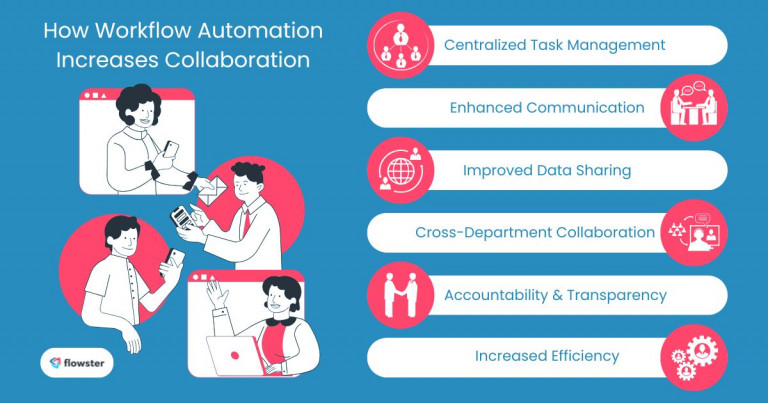In today’s fast-paced digital marketing landscape, efficiency and collaboration are paramount. Workflow automation has emerged as a powerful tool that can significantly enhance these aspects for marketing agencies. By automating repetitive tasks and streamlining workflows, agencies can free up valuable time and resources, allowing teams to focus on strategic initiatives and creative endeavors.
Collaboration is the lifeblood of any successful marketing agency. When teams work seamlessly together, ideas flow freely, and projects are executed with precision. Workflow automation increases collaboration by breaking down silos, improving communication, and fostering a more cohesive work environment. By eliminating manual tasks and reducing bottlenecks, automation enables teams to work more efficiently and effectively, ultimately leading to better results.
Article Outline
What is Workflow Automation?
Workflow automation is the process of automating repetitive tasks and streamlining workflows to increase efficiency and productivity. By using specialized software and tools, marketing agencies can automate various aspects of their operations, from client onboarding to content creation and campaign management.
What Is Workflow Automation?
At its core, workflow automation involves creating a series of rules and triggers to automate specific actions. For example, when a new client signs a contract, a workflow can be triggered to automatically send a welcome email, assign tasks to team members, and update project management tools. This eliminates manual intervention and reduces the risk of human error.
Common Tools and Platforms Used in Marketing Agencies
Several tools and platforms can be used to implement workflow automation in marketing agencies. Some of the most popular options include:
- Project management tools: These tools, such as Asana, Trello, and Basecamp, help teams organize and track projects. They can be integrated with workflow automation tools to automate task assignments, notifications, and status updates.
- Marketing automation platforms: These platforms, such as HubSpot, Marketo, and Pardot, automate marketing tasks like email marketing, lead nurturing, and social media posting.
- CRM software: CRM software, such as Salesforce and Pipedrive, helps manage customer relationships. Workflow automation can be used to automate tasks like lead scoring, opportunity management, and customer support.
- Flowster: A powerful and user-friendly workflow automation tool specifically designed for marketing agencies. Flowster allows you to create custom workflows to automate repetitive tasks, improve team collaboration, and streamline your agency’s operations.
By leveraging these tools, marketing agencies can significantly improve their efficiency and productivity. This concept is further explored in Flowster’s comprehensive guide on campaign automation, Supercharge Your Marketing with Campaign Automation: A Comprehensive Guide. Read now.
In the next section, we’ll delve deeper into how workflow automation specifically increases collaboration within marketing teams.
Capture Your Processes in Minutes!
How Workflow Automation Increases Collaboration
Workflow automation is a game-changer when it comes to fostering collaboration within marketing agencies. By streamlining processes and improving communication, it empowers teams to work together more efficiently and effectively.
Centralized Task Management
One of the primary benefits of workflow automation is the ability to centralize task management. By using a centralized platform, all team members can access and update project information in real-time. This eliminates the need for multiple spreadsheets, email chains, and other fragmented communication channels.
- Real-time project tracking: Centralized task management allows teams to track the progress of projects in real-time. This visibility helps identify potential bottlenecks, allocate resources effectively, and ensure that deadlines are met.
Enhanced Communication
Workflow automation can significantly improve communication within marketing teams. By automating routine tasks and notifications, teams can focus on more strategic work and collaboration.
- Real-time updates: Automated notifications and alerts keep team members informed about project updates, deadlines, and changes. This ensures that everyone is on the same page and reduces the risk of miscommunication.
- Quick feedback loops: Workflow automation can facilitate quick feedback loops by automating task assignments, approvals, and review processes. This allows teams to iterate on ideas and make decisions more quickly.
Improved Data Sharing
Workflow automation can improve data sharing by providing easy access to information and documents. By storing all project-related information in a centralized repository, teams can collaborate more effectively and make informed decisions.
- Shared access to information and documents: Centralized data storage ensures that all team members have access to the latest information and can collaborate on documents simultaneously.
- Impact on decision-making and collaboration: Improved data sharing can lead to better decision-making and increased collaboration. When teams have access to the same information, they can work together more effectively to solve problems and achieve common goals.

Cross-Department Collaboration
Workflow automation can break down silos between different departments, such as marketing, sales, and design. By automating tasks and integrating workflows, teams can collaborate more seamlessly on cross-functional projects.
- Integrated workflows for collaborative projects: Workflow automation can help integrate workflows across different departments, ensuring that everyone is aligned and working towards the same goals.
Accountability and Transparency
Workflow automation can increase accountability and transparency within marketing teams. By automating task assignments and tracking progress, it’s easier to identify who is responsible for specific tasks and monitor their performance.
- Automated task assignments: By automating task assignments, workflow automation can clarify responsibilities and reduce the risk of tasks falling through the cracks.
- Impact on team morale and project outcomes: Increased accountability and transparency can boost team morale and lead to better project outcomes.
Increased Efficiency
By automating repetitive tasks, workflow automation can free up team members’ time to focus on more strategic and creative work. This can lead to increased productivity and better overall performance.
- Freeing up time for high-value tasks: Workflow automation can automate tasks like data entry, report generation, and email marketing, freeing up team members’ time to focus on high-value tasks.
- Impact on individual productivity and team collaboration: Increased efficiency can boost individual productivity and improve team collaboration by reducing the time spent on routine tasks.
In the next section, we’ll explore a real-world example of how workflow automation has transformed a marketing agency: the case of Ralista Carter.
Case Study: How Ralista Carter Boosted Collaboration with Workflow Automation
Want to see a real-life example of how workflow automation can supercharge collaboration in a marketing agency? Check out this insightful video by Ralista Carter.
In her presentation, Ralista dives into the key challenges that marketing agencies face when it comes to collaboration and how workflow automation can address these issues.
Here are some key takeaways from Ralista’s video that highlight the link between workflow automation and increased collaboration:
- Eliminating communication bottlenecks: Ralista emphasizes how workflow automation can streamline communication by automating task assignments, notifications, and updates. This reduces reliance on email chains and fosters real-time collaboration.
- Breaking down departmental silos: Traditional workflows can create silos between departments like marketing, design, and sales. Ralista discusses how integrated workflows can bridge these gaps, allowing teams to work together seamlessly on projects.
- Improving project visibility: A central platform for managing tasks and documents provides everyone with a clear view of project progress. This enhances transparency and accountability, leading to better collaboration across all levels.
Ralista’s case study effectively demonstrates how workflow automation can transform the way marketing agencies operate. By fostering improved communication, breaking down silos, and boosting project visibility, workflow automation paves the way for a more collaborative and productive work environment.
Now that you understand how workflow automation empowers collaboration, take the next step by exploring Flowster’s guide on building a digital marketing workflow blueprint: The 9-Step Digital Marketing Workflow Blueprint for Growth. Read now.
Now, let’s wrap up this blog post by summarizing the key takeaways and outlining the next steps you can take to leverage workflow automation in your own marketing agency.
Flowster's AI-Driven Automation
Conclusion: Empower Your Agency with Workflow Automation
In conclusion, workflow automation is a powerful tool that can significantly enhance collaboration within marketing agencies. By streamlining processes, improving communication, and breaking down silos, automation empowers teams to work together more efficiently and effectively.
Don’t wait to reap the benefits of workflow automation. Start by identifying repetitive tasks and communication bottlenecks within your agency. Then explore workflow automation tools like Flowster to streamline these processes and foster a more collaborative work environment.
To get started, take advantage of Flowster’s free workflow templates. These templates can help you quickly automate common tasks and improve collaboration within your team.
By embracing workflow automation, you can unlock your agency’s full potential and achieve greater success.




